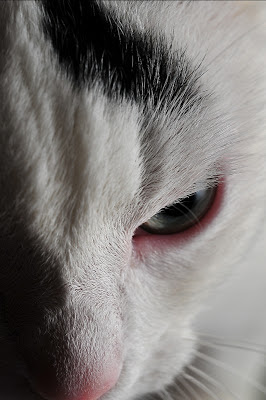Here's my no-nonsense, cut-to-the-chase list of the 5 most important tips for great cat photos. As with everything else I'm sharing with you, this is a product of years of personal experience. In photography and... as a cat tamer :P
(dog lovers, worry not. There will be an article about you too in the future!)
 |
| A shot showing the importance of a) anticipation; b) timing; c) pre-focusing |
1. The PAR Rule: Plan, Anticipate, Recreate.
This is something you might find useful in general photography as well, but it works particularly well with cats, because they are creatures of habit. Living with them, you learn to anticipate their movements (although they can often surprise us!). So, Plan what kind of photo you want to take of them. It should be something interesting, or something showing their unique personality. Say, your cat loves to jump high up in the air trying to grab a toy (what cat wouldn't?). Set up your equipment, have all settings ready (more about this below), then lure your cat into action. The next step is to Anticipate - knowing your cat, you can probably tell when she is about to jump. Be ready! Even if you get it right the first time (rarely that happens), opt for a few more shots. So, Recreate the situation - it should be easy enough to do that a few times before the cat loses interest.
2. Settings for Fast-Moving Furry Friends
This of course depends on what you're trying to achieve, but if this involves fast action (as in our example above), the shutter speed should be 1/500 or faster. Even more important than shutter speed is the aperture. The reason is that when photographing cats the depth of field is very small (as the distances are small). Pairing to the fact that they can move really fast, and before you know it they're outside the focus zone. Use a smaller aperture for increased latitude - here you will also realize the importance of anticipating action. Keep reading
3. The Art of Focusing, Lvl: Cat!
Taking photos of cats is almost as challenging in terms of focusing as taking photos of flying bugs. Cats are fast, they jump, the depth of field is short. Well, once again, the experienced photographer goes around the issue by anticipating. What that means for focusing is this: Pre-Focus where you will anticipate the cat will be, then fire once she's on her way there. Trust me, it works better than any AF-C of any camera. Your cat is way faster than your finger tripping the shutter, so by the time you'll press the button, she'll be there! It might take couple of attempts, but the result will be worth it.
 |
| Variety in perspectives, framing, and angles, can contribute in creating more unique photos |
4. Remember: Portraits Are about Capturing Someone's True Essence
And this is the same for cats. Is your cat playful? Lazy? Looking Bored? Bring that up in your photo! Sure enough, most cats are most of these things on different occasions, but express something with your photography. Don't just snap a cat "mugshot". Take a photo of your cat doing something. Experiment with perspectives, be different!
5. If You Can Get an Assistant, Things Get more Interesting!
If you don't, no big deal. You can still capture great images. But if you have someone to help you, things can be easier. S/he can be playing with the cat (or attracting her attention), while you're focusing on taking pictures. If that is the case, you should try to be even more creative with your positioning and angles. Remember: The key to originality is doing things nobody else has done before (duh!).
**Important Reminder**
Your cat (like any other pet) is a living creature. This might seem self-obvious, but never, ever cause your beloved cat stress (not to mention put her in harm's way) just to get a picture. If she doesn't want to play anymore, let her be and try later.
No comments:
Post a Comment